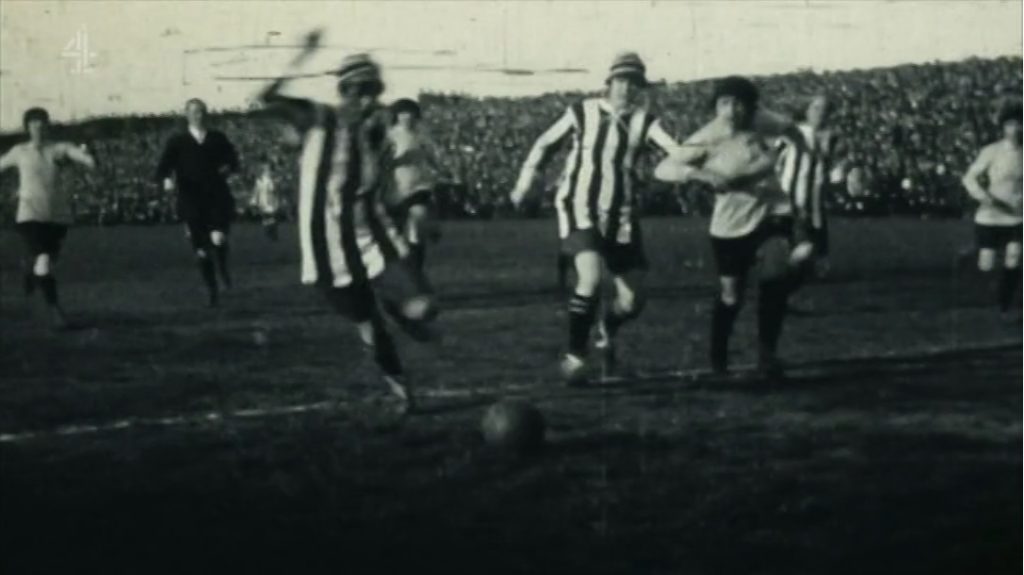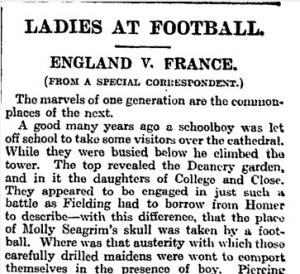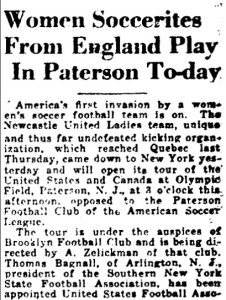In this week’s blog I’m using some of the Library’s online resources to find primary source material relating to the popularity of women’s football during and just after the First World War and the decision by the FA to ban it.
The other night on catch-up I watched the Channel 4 documentary When Football Banned Women, programmed to coincide with the Women’s EURO 2017 (which Channel 4 just happens to be showing, it’s like they thought about their programming or something!) This interesting documentary looked at the rise in popularity of women’s football during the First World War and the subsequent decline after the decision by The Football Association (FA) to ban the women’s game in 1921.
If you’ve not seen it you can watch it on Box of Broadcasts (BoB).

Screenshot from ‘When Football Banned Women’ (Channel 4).
As I am always looking for an excuse to use some of the University Library’s fantastic online primary source collections, I decided this was a perfect story to try and find out more about from our online archives.
While I primarily used some of the online newspaper archives the Library has access to for that period, I did do some searching in some other primary source collections that covered the period in question. You can find a list of the specific databases I used at the end of the post.
Women’s football in the First World War
With 1000s of men being called up to fight in the First World War, women were expected to take on roles as never before in the workplace and with this came other opportunities. Women’s football teams began to form, often put together or sponsored by the industries and companies now employing the vast female workforce. These teams began to play matches with the primary aim of raising money for charity and while spectators may have originally attended to help raise money and to watch what they thought of as a novelty, they continued to attend as the matches were good and the teams had skill.

Screenshot from The Times Digital Archive (1785-2011).
As an article in The Times from 1920 about a football match between Dick, Kerr Ladies, one of the most successful teams at this time, and the French national women’s team states “It was a hard, sporting game, and it was treated by both teams as a sport and not a spectacle. Both looked to enjoy it, and exhibited quite enough skill to disappoint those who had come to laugh.”1 I would point out that the same article has lines like “There was heading too, and the instinctive stoppage of the header to adjust her hair never failed to please.”2, which is very common for the tone of all articles I found about these teams however complimentary about the actual playing.
To give some sort of idea though on how popular women’s football became at that time, on the 26th December 1920 Dick, Kerr Ladies played a match against St. Helens women’s team. The Guardian reports that this was a match to raise money for injured and out of work soldiers and sailors and over 45,000 spectators attended3. To put this in some perspective, on the same day the same number of spectators watched the First Division Birmingham v. West Ham match and only 4 other men’s First Division matches managed to draw more crowds4.
So why the ban?
From the beginning of the formation of these teams during the First World War, the teams themselves and their supporters had to argue for their right to play, the suitability of the game for women and to be taken seriously as football players.
In an article in The “Bombshell” from June 2017 it argues, quite rightly in my opinion:
“In their great and determined effort to save their country, women have not only taken on their shoulders the work of man, but his pastimes and recreations as well. It is the opinion of some people that playing football destroys woman’s chief charm – that elusive and indefinable quality which for want of a better word we call “femininity.” But if we can learn to apply the rules of football and cricket outside the playing fields to the great game of life, if we can “play the game” at our work as well as at our sport, then it will be worth, more than worth any real or imaginary sacrifice of early Victorian ideals.”5
And in 1920 the then captain of the Dick, Kerr Ladies team, Alice Kell, wrote a passionate article in support of women’s football in the run up to a small number of games the team were to play against the French women’s football team. She notes “I do not wish small minded people to labour long under the delusion that they may, by attending these matches, see an open-air pantomime or revue.” Indeed, as she states “We are told that sport laid the foundation of the spirit and constitution that won the war; that being so, the nation of the future should also enjoy the advantages of a fully developed and healthy womanhood.”6

Screenshot from Victorian Popular Culture.
However, in December 1921 the FA passed a resolution “requesting football clubs to refuse the use of their grounds for women footballers, as they considered the game unsuitable for the females”7.
The Times reports the full resolution in a short article on the 6th December.
“Complaints have been made as to football being played by women, the Council feel impelled to express their strong opinion that the game of football is quite unsuitable for females and out not be encouraged. Complaints have also been made as to the conditions under which some of these matches have been arranged and played, and the appropriation of the receipts to other than charitable objects. The Council are further of opinion that an excessive proportion of the receipts are absorbed in expenses and an inadequate percentage devoted to charitable objects. For these reasons the Council request clubs belonging to the Association to refuse the use of their grounds for such matches.”8
Despite these alleged financial irregularities it is the “unsuitability” of the game for women that the press and public latched onto as the key element to this story showing that while times may have changed from the “Victorian ideals”, in many quarters they hadn’t changed that much.
While many of the reports do state, as in an article from The Times of India in December 1921, that “medical opinion is divided”9 as to whether women should play football or not and as The Guardian notes “Perhaps this point would have been settled with more authority by women themselves”10, they do generally choose to believe those who are against it.
Dr. Mary Scharlieb, a renowned gynaecologist is consistently quoted as saying football is “too much for a woman’s physical frame”11. As is Mr Eustace Miles (the papers never actually say who he is but I am presuming is the “sportsman, writer, and food reformer”12) who claims rather preposterously that “Kicking is too jerky a movement for women.”13 Another unnamed physician is quoted as saying “If you ask me whether football, as I know it, is suitable, I reply that it is physically impossible for women to play the game as men play it. They can neither run, kick nor charge as men do.”14
Even the Dean of Durham, Bishop Welldon, chimes in saying that while he hopes women “can enjoy all the exercise which is so desirable for their health and their character” this does not, in his opinion, include football and he is worried that those women that do “will lose something of the refinement which is womanhood’s peculiar grace, and my hope is, therefore, that they will, in their own interests, choose other games of a less violent nature”15. Aah, “that elusive and indefinable quality”16 of feminity again!
So what happened next?
Well, while this was undeniably an attempt to kill off the women’s game it didn’t entirely work. In an article in The Guardian regarding the ban it states “If there is any real desire to have women football teams the action of the F.A. can hardly put an end to the forming of them, nor can it prevent the teams from acquiring grounds of their own.”17 And that is basically what happened, while many teams did fall by the wayside a number of them endured and new teams were formed. They didn’t get the attention and the supporters that they had during the period 1917-1921 and they got nowhere near the amount of attention, promotion, sponsorship, etc., of the men’s game but they did continue.

Screenshot from New York Tribune (1841-1922), ProQuest Historical Newspapers.
Dick, Kerr Ladies continued to play matches to raise money for charity18 and in 1922 took part in a short tour of the United States, though they were often referred to as Newcastle United Ladies19. The team disbanded in 1965.
The ban was finally lifted by the FA in 1971 but while the women’s game goes from strength to strength, the damage done by the ban was long lasting and there is still a long way to go.
A forgotten history?
The documentary, When Football Banned Women, makes a big deal about the story being a forgotten part of our history. And while there is no doubt this isn’t a story that is widely known it hasn’t been forgotten.
Gail Newsham is interviewed extensively in the documentary and you can borrow her thorough history of the Dick, Kerr Ladies team In a league of their own : the Dick, Kerr Ladies’ Football Club from Moray House Library.
And this story has been told on TV before too:
Nation on Film: Women’s Football from the BBC.
Part 3 of Amanda Vickery’s Suffragettes Forever! The Story of Women and Power, includes a section on women’s football and the Dick, Kerr Ladies team.
Kate Adie’s The Women of World War One takes a look at the story this time from the perspective of another successful team at the time, Blyth Spartans Munition Girls.
And in 2011 The One Show featured the story of women’s football during this period, again focussing on the Dick, Kerr Ladies.
And let’s not forget that this was not the first time women had tried to play football at a professional or semi-professional level. The story of the short-lived British Ladies’ Football Club (BLFC), from 1894 to 1896, could be a whole other blog post in itself. According to this highly biased article from the Pall Mall Gazette in 1895 when the female players first took to the pitch
“There was a roar of laughter that permeated the empyrean. Hundreds fell off the fence. Tears rolled down the cheeks of men who had never been known to weep in public. Other men who were incapable of deep feeling of this variety fell upon each other’s necks and shoulders for mutual support. Small boys fell into paroxysms. Women smiled and blushed.”20
This article is no doubt hugely exaggerated but it is indicative of the kind of tone taken in the vast majority of articles about the BLFC and the club folded after just a couple of years.
Online primary sources used
I did fairly brief searches of the various different databases but it shows how much you can find with just some simple searches. As well as DiscoverEd the databases I used were:
- Box of Broadcasts (BoB)
- British Library Newspapers, parts I-V
- The Guardian (1821-2003) and The Observer (1791-2003), ProQuest Historical Newspapers
- New York Tribune (1841-1922), ProQuest Historical Newspapers
- The Scotsman (1817-1950), ProQuest Historical Newspapers
- The Times Digital Archive (1785-2011)
- The Times of India (1838-2007), ProQuest Historical Newspapers
- Victorian Popular Culture
- Women, War and Society, 1914-1918 from Archives Unbound
All the online archives mentioned above can be accessed via the Databases A-Z list or Databases by Subject pages.
Access is only available to current students and staff at University of Edinburgh.
Note that Box of Broadcasts (BoB) is only available on the UK mainland (using VPN may help you get round this). And you will normally be asked to provide your University email address the first time you log in to BoB.
Caroline Stirling – Academic Support Librarian for History, Classics and Archaeology
Notes
- (FROM A SPECIAL CORRESPONDENT.). “Ladies At Football,” Times, May 7, 1920, accessed July 27, 2017. http://tinyurl.galegroup.com.ezproxy.is.ed.ac.uk/tinyurl/54mZNX.
- Ibid.
- “Women’s Football for Charity,” The Guardian, Dec 28, 1920, accessed July 27, 2017. https://search-proquest-com.ezproxy.is.ed.ac.uk/docview/476417438?accountid=10673
- “Two Days’ Holiday Football: Five Lancashire Clubs Leading the First Division,” The Guardian, Dec 28, 1920, accessed July 27, 2017. https://search-proquest-com.ezproxy.is.ed.ac.uk/docview/476418682?accountid=10673
- “Playing the game,” The “Bombshell”, June, 1917, accessed 21 July, 2017. http://tinyurl.galegroup.com.ezproxy.is.ed.ac.uk/tinyurl/53vL59.
- “Football Mud-Larks for Women,” World’s pictorial news: exclusive news, best pictures, the week’s sport, powerful serials, theatrical notes, society gossip, Apr 30, 1920, accessed July 21, 2017). http://www.victorianpopularculture.amdigital.co.uk.ezproxy.is.ed.ac.uk/Documents/Details/EXEBD_21835.
- “The Football-Playing Women,” The Scotsman (1921-1950), Dec 07, 1921, accessed July 21, 2017. https://search-proquest-com.ezproxy.is.ed.ac.uk/docview/479222709?accountid=10673.
- “Women Football Players,” Times, Dec 06, 1921, accessed July 27, 2017. http://tinyurl.galegroup.com.ezproxy.is.ed.ac.uk/tinyurl/54o8N6.
- “The Ban,” The Times of India (1861-Current), Dec 31, 1921, accessed July 21, 2017. https://search-proquest-com.ezproxy.is.ed.ac.uk/docview/304967429?accountid=10673.
- “Football for Women,” The Manchester Guardian (1901-1959), Dec 06, 1921, accessed July 21, 2017. https://search-proquest-com.ezproxy.is.ed.ac.uk/docview/476543982?accountid=10673.
- “The Ban”
- Brigid Allen, ‘Miles, Eustace Hamilton (1868–1948)’, Oxford Dictionary of National Biography, Oxford University Press, 2004; online edn, Sept 2014, accessed July 27, 2017. http://www.oxforddnb.com/view/article/50457.
- “The Ban”
- Ibid.
- “Football and Grace,” The Irish Times (1921-Current File), Dec 19, 1921, accessed July 21, 2017. https://search-proquest-com.ezproxy.is.ed.ac.uk/docview/520326754?accountid=10673.
- “Playing the game.”
- “Football for Women.”
- “Women’s Football Receipts For Charities,” The Manchester Guardian (1901-1959), Apr 06, 1922, accessed July 21, 2017. https://search-proquest-com.ezproxy.is.ed.ac.uk/docview/476585045?accountid=10673.
- “Women Soccerites from England Play in Paterson to-Day,” New – York Tribune (1911-1922), Sep 24, 1922, accessed July 26, 2017. https://search-proquest-com.ezproxy.is.ed.ac.uk/docview/576680525?accountid=10673.
- “Female Football Enthusiasts,” Pall Mall Gazette, Mar 25, 1895, accessed July 27, 2017. http://tinyurl.galegroup.com.ezproxy.is.ed.ac.uk/tinyurl/54qNQ9.

Pingback: #100years: “Because…we want to get on with our work more quickly” | HCA Librarian